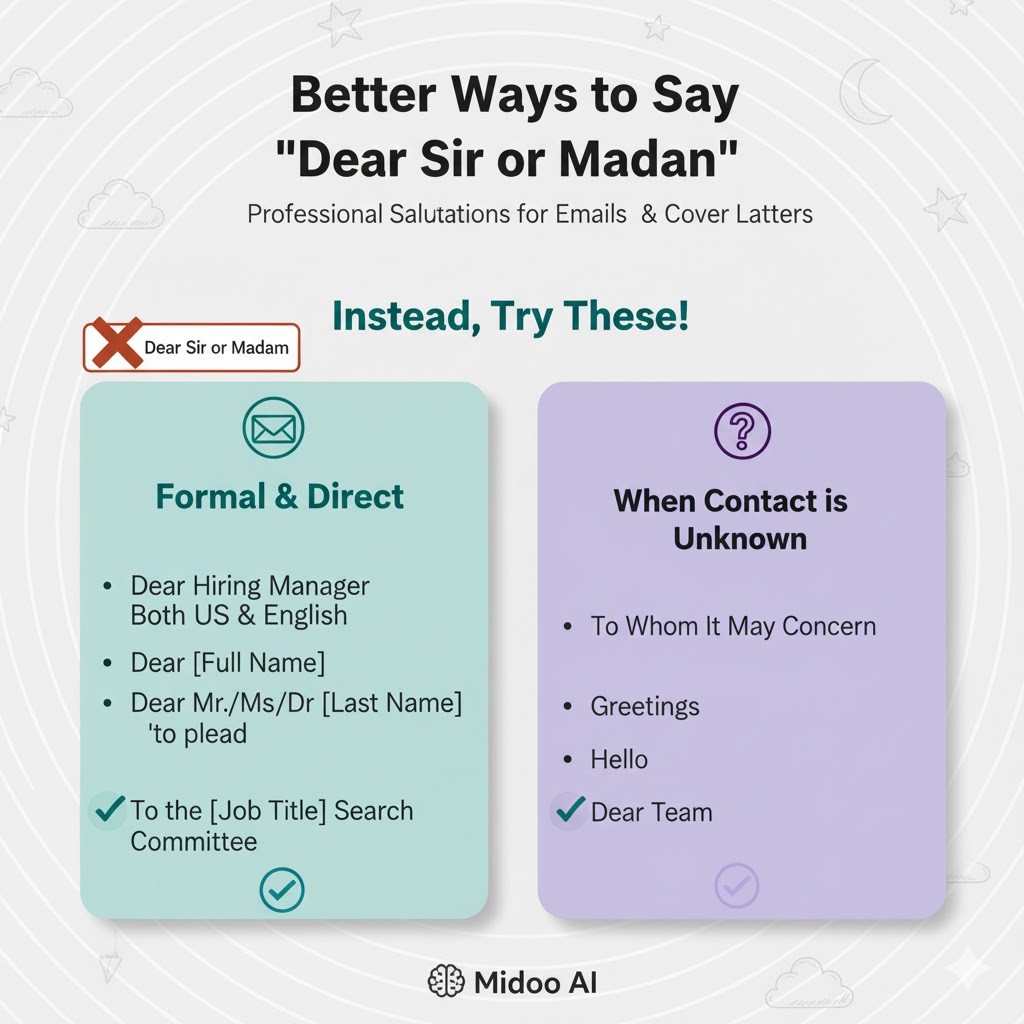Better Ways to Say “Dear Sir or Madam” in Emails and Cover Letters

Starting an email or cover letter can be surprisingly stressful. You want to sound polite and professional—but not old-fashioned. The phrase “Dear Sir or Madam” used to be the go-to greeting, but today, it often sounds too formal or impersonal.
At Midoo AI, we help English learners and professionals write naturally and confidently in real-life situations. So today, let’s look at when “Dear Sir or Madam” still works, and what better, more modern options you can use instead.
1. Why People Use “Dear Sir or Madam”
Traditionally, “Dear Sir or Madam” was used when you didn’t know the recipient’s name. It’s polite and formal, but it’s also generic and outdated.
Example:
Dear Sir or Madam,
I am writing to apply for the position of Marketing Assistant at your company.
While this sounds respectful, it doesn’t show effort to personalize your message. In modern communication, personalization is key.
Tip:
Always try to find the recipient’s name before using a generic greeting. It shows initiative and attention to detail.
2. When “Dear Sir or Madam” Is Still Acceptable
There are a few formal or traditional settings where this phrase still works:
- Official government correspondence
- Legal or complaint letters
- Very formal corporate communication
Example:
Dear Sir or Madam,
I am writing to file a formal complaint regarding your service.
Tip:
If you’re unsure about tone or formality, use “Dear Sir or Madam” only as a last resort.
3. Better Alternatives (When You Don’t Know the Name)
If you don’t have the recipient’s name, you can still sound professional and warm with these alternatives:
| Alternative | When to Use | Example |
|---|---|---|
| Dear Hiring Manager | Job applications | Dear Hiring Manager, I’m excited to apply for the role of Content Writer. |
| Dear Department Team | When writing to a department | Dear Customer Support Team, could you help me with my recent order? |
| Dear Job Title | If you know the position | Dear Human Resources Director, I’d like to inquire about open positions. |
| Dear Company Name Team | When addressing a brand | Dear Midoo AI Team, I appreciate your latest update—it’s impressive! |
| Dear Recruiter | For general job inquiries | Dear Recruiter, I’m reaching out regarding potential openings. |
Tip:
Using the company or department name feels more personal than the old-fashioned “Sir or Madam.”
4. When You Do Know the Name
Whenever possible, use the person’s actual name—it’s the most effective way to start any message.
Examples:
- Dear Mr. Johnson,
- Dear Ms. Kim,
- Dear Dr. Patel,
- Dear Alex,
If you’re unsure of gender or title, use the full name:
Dear Taylor Morgan,
Tip:
Check LinkedIn or the company’s “About” page to find the right name. It only takes a minute and instantly makes your email stand out.
5. Friendly and Neutral Alternatives
Sometimes, especially in less formal emails, you can use modern greetings that still sound respectful:
Examples:
- Hello,
- Hi there,
- Good morning,
- Greetings,
These are great for customer service, professional networking, or following up on prior communication.
Tip:
Avoid being too casual in your first email—skip greetings like “Hey” or “Yo” unless you already have an informal relationship.
6. How to Choose the Right Greeting
| Situation | Best Greeting |
|---|---|
| Job application | Dear Hiring Manager / Dear Name |
| Email to a company | Dear Company Name Team |
| Customer service inquiry | Hello / Dear Support Team |
| Networking email | Dear Name / Hello Name |
| Government or legal letter | Dear Sir or Madam |
Tip:
Match your greeting’s tone to your goal: the more personal your message, the more specific your greeting should be.
FAQ
Q1: Is “Dear Sir or Madam” rude?
No, it’s not rude—it’s just outdated. It sounds too formal for most modern emails.
Q2: What if I can’t find a name?
Use “Dear Hiring Manager” or “Dear Department Team.” They’re still professional but sound more natural.
Q3: Should I use “To Whom It May Concern”?
It’s even more outdated than “Dear Sir or Madam.” Avoid it unless writing a reference letter or formal document.
Q4: Can I start an email with “Hello”?
Yes, if the email is professional but not overly formal. “Hello” works well in most business situations.
Q5: What about cultural differences?
In the U.K. and U.S., personalization is valued. In very formal Asian business contexts, “Dear Sir or Madam” might still be acceptable.
Final Tip from Midoo AI
The way you open an email sets the tone for everything that follows.
“Dear Sir or Madam” isn’t wrong—but it’s not your best choice anymore.
Whenever possible, use a real name or a specific title. It shows care, research, and professionalism.
At Midoo AI, we help you master natural English communication—so whether you’re writing a cover letter, pitching a client, or applying for your dream job, your first impression will always sound polished and modern.